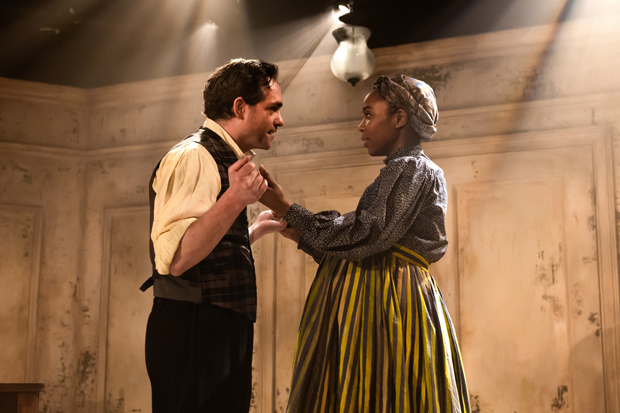Exploring the Price of a Major Medical Breakthrough in Behind the Sheet
Playwright Charly Evon Simpson gives a voice to those who sacrificed everything.

(© Jeremy Daniel)
Thirty experimental surgeries. Thirty experimental surgeries without anesthetic. Can you imagine that? For us, it seems like a nightmare. For the women at the heart of Charly Evon Simpson's Behind the Sheet, now running at Ensemble Studio Theatre, it's one of many brutal realities about their lives and health in 1846 that doesn't get any easier.
Philomena (Naomi Lorrain) is a 19-year-old slave owned and impregnated by George (Joel Ripka), a medical doctor specializing in gynecological matters. George has invented a new device he calls the speculum, which allows for closer examination of the female pelvic region. Now he's moved on to a more advanced task: trying to figure out how to repair vesicovaginal fistulas, tears between the uterus and the bladder, formed after prolonged labor.
Simpson's 90-minute drama explores these medical breakthroughs through dueling perspectives. One is that of George — modeled after the controversial real-life figure J. Marion Sims, known as the "father of modern gynecology." The other is that of Philomena, who involuntarily enabled his trip to the history books. George, like Sims, uses enslaved black women as his test subjects, taking ownership of the afflicted from their masters until their treatments are completed.
The grueling process of trial and error meant that the women endured dozens of experimental procedures, which Simpson depicts this in harrowing detail as Philomena becomes an unwitting patient — until George discovers the perfect fix — at a major cost.

(© Jeremy Daniel)
Ensemble Studio Theatre, with the sponsoring Alfred P. Sloan Foundation, has given Behind the Sheet a substantial production for such a small space. Colette Robert's staging is defined by its opulence — an appropriately shopworn set by Lawrence E. Moten III, detailed period costumes by Sarah Woodham, haunting lighting by Adam Honoré, and sound design by Fan Zhang that literally vibrates the theater. Lorrain's wrenching emotional performance is well balanced by the cool, calculated Ripka. The remaining seven ensemble members are very, very good at drawing distinctive characters when they don't often have a lot to work with.
Simpson is still developing her voice as a playwright; Behind the Sheet is not without the problems seen in many works by early career writers. Each scene is a little too long and shaggy, there are a few too many characters, and certain plot points fall by the wayside. But Simpson must be commended for giving a voice to the voiceless — as far as I can tell, this is one of the first dramatic works written about this particular subject — and it's a brave, unflinching piece from top to bottom. The amount of thought and care that went into its development is evident, a departure from this era where slapdash theater has more or less overtaken us.
Behind the Sheet may not be a perfect play, but it's a story that deserves to be heard. Thankfully, Simpson is here to give it to us in all of her fearless glory.







